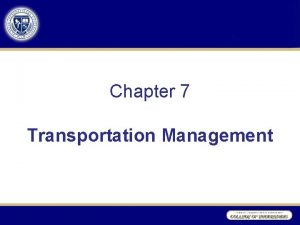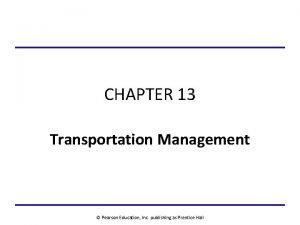Shipper C New 50 MDthd Firm Load Shipper


- Slides: 2

Shipper C New 50 MDth/d Firm Load Shipper A Shipper B MDO = 100 MDth/d MDO = 200 MDth/d CMQ = 80 MDth/d CMQ = 50 MDth/d Lateral capacity = 300 MDth/d Given: • Shipper A and Shipper B CMQ and MDO’s as stated above (no other shippers on lateral) • New Shipper C requesting firm 50 MDth/d load at a new delivery adjacent to Shipper A and Shipper B delivery points • Total of Shipper A and Shipper B MDO’s equal to lateral capacity Determine: • Shipper A and Shipper B MDO reductions to accommodate new Shipper C firm transportation request of 50 MDth/d Methodology: 1. 2. Determine total MDO in excess of total CMQ. a. Excess MDO Shipper A = (100 -80) MDth/d = 20 MDth/d; Excess MDO Shipper B = (200 -50) MDth/d = 150 MDth/d b. Total Excess MDO Shipper A + Shipper B = (20+150) = 170 MDth/d Determine total MDO available after 50 MDth/d firm transportation request. a. 3. 4. MDO Available after request = Total Excess MDO – Firm Transportation Request = (170 -50) MDth/d = 120 MDth/d Determine allocation of remaining MDO to Shipper A and Shipper B based on pro-rata CMQ a. Shipper A allocation of MDO in excess of CMQ = (CMQ Shipper A/Total CMQ)*Available MDO = (80/(80+50))*120 = 74 MDth/d b. Shipper B allocation of MDO in excess of CMQ = (CMQ Shipper B/Total CMQ)*Available MDO = (50/(80+50))*120 = 46 MDth/d Determine new MDO’s for Shipper A and Shipper B (subject to the limitation that new MDO cannot exceed original MDO) a. New Shipper A MDO = CMQ+Shipper A allocation of MDO = (80+74) MDth/d = 154 MDth/d. New MDO cannot be greater than existing MDO, implying new MDO Shipper A = 100 MDth/d (unchanged). b. Therefore all MDO reductions will come from Shipper B. New Shipper B MDO = (200 -50) MDth/d = 150 MDth/d

Shipper C New 50 MDth/d Firm Load Shipper A Shipper B MDO = 100 MDth/d MDO = 200 MDth/d CMQ = 80 MDth/d CMQ = 150 MDth/d Lateral capacity = 300 MDth/d Given: • Shipper A and Shipper B CMQ and MDO’s as stated above (no other shippers on lateral) • New Shipper C requesting firm 50 MDth/d load at a new delivery adjacent to Shipper A and Shipper B delivery points • Total of Shipper A and Shipper B MDO’s equal to lateral capacity Determine: • Shipper A and Shipper B MDO reductions to accommodate new Shipper C firm transportation request of 50 MDth/d Methodology: 1. 2. Determine total MDO in excess of total CMQ. a. Excess MDO Shipper A = (100 -80) MDth/d = 20 MDth/d; Excess MDO Shipper B = (200 -150) MDth/d = 50 MDth/d b. Total Excess MDO Shipper A + Shipper B = (20+50) = 70 MDth/d Determine total MDO available after 50 MDth/d firm transportation request. a. 3. 4. MDO Available after request = Total Excess MDO – Firm Transportation Request = (70 -50) MDth/d = 20 MDth/d Determine allocation of remaining MDO to Shipper A and Shipper B based on pro-rata CMQ a. Shipper A allocation of MDO in excess of CMQ = (CMQ Shipper A/Total CMQ)*Available MDO = (80/(80+150))*20 = 7 MDth/d b. Shipper B allocation of MDO in excess of CMQ = (CMQ Shipper B/Total CMQ)*Available MDO = (150/(80+150))*20 = 13 MDth/d Determine new MDO’s for Shipper A and Shipper B a. New Shipper A MDO = CMQ+Shipper A allocation of MDO = (80+7) MDth/d = 87 MDth/d. b. New Shipper B MDO = CMQ+Shipper B allocation of MDO = (150+13) MDth/d = 163 MDth/d



